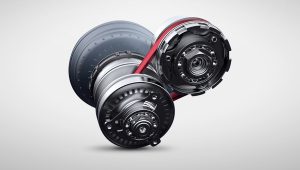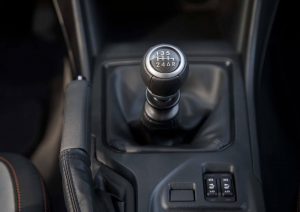I recently spent a week test driving a ’24 Subaru Crosstrek – which is now an automatic (CVT) only Crosstrek.
Full review is here.
2023 – the model year just ended – was the last calendar year you could buy a Crosstrek with a manual transmission. These were so popular it was almost impossible to buy a Crosstrek so equipped – which begs the question: Why did Subaru decide to stop selling them?
Well, Subaru didn’t.
Not in terms of having much choice.
The government leaving little in the way of that.
Here’s the deal in a pair of stats: The ’24 CVT-only Crosstrek with the standard 2.0 liter four carries an EPA MPG rating of 27 city, 34 highway. The ’23 Crosstrek with the same 2.0 engine and otherwise the same in every way except for its standard six speed manual transmission carries an EPA MPG rating of 22 city, 29 highway.
That roughly 5 MPG difference makes all the difference . . . to the government. And – thereby – to Subaru. Which must deal with the government and its mandatory-minimum MPG requirements. One way it deals with them – or rather, one way it complies with them – is by getting rid of transmissions that can’t be programmed to perform best on government tests. As by shifting up sooner rather than later, which reduces engine RPM and so increases gas mileage.
Never mind that on the road, the driver will likely force a downshift to a lower gear – by pushing down harder on the accelerator pedal, in order to wring some acceleration out of the vehicle. The only way to mirror the test results on the road is by driving without moving, almost.
But it doesn’t matter that in real-world driving, the programmed car will probably not deliver the mileage touted by the results of the government tests. What matters is that the programming helped Subaru (and all the others that have gone automatic-only) do better on the tests that determine compliance.
Since a manual can’t be programmed, it gets eliminated. And that’s why the ’24 Crosstrek is no longer available with one of the features that made it more appealing than other already-automatic-only crossovers. Though not quick, it was fun – because at least there was something to do. It was also empowering – because it is always true that when the driver has control over the drivetrain, he has more control over the vehicle. You decide when to shift up – or down. You can raise the engine’s RPMs to wherever you like before engaging the clutch. You can feather the clutch, to control how the vehicle launches.
Automatics take that all away. Plus something else – if the automatic is a CVT, which doesn’t shift up or down. These latter are even more desirable than programmable automatics with programmable shift points because they’re even more conducive to compliance. The reason for that being they don’t shift at all. Instead, they vary the range – which is a way to continuously alter the leverage for maximum MPGs (on the test). That is the only reason for the proliferation of CVTs, which don’t offer a performance or longevity advantage over automatics that shift.
They are simply more “efficient.”
But they’re not more reliable. The reason for that being the nature of the layout. Most CVTs use a pair of pulleys that expand and contract – with a belt that rides in between – and this is how you get continuously varying leverage between the engine and the drive wheels. The transmission is always in the “sweet spot” of its range to eke out the most mileage from the engine at a given road speed. But in order to do this, the belt that rides in between the pulleys must expand and contract, continuously. This inevitably weakens the belt, which eventually snaps – and there goes the CVT.
Which will cost much more to replace than a clutch – when the latter eventually wears out. This generally won’t happen with a modern, manual-equipped car until the vehicle has accumulated 140,000-plus miles, absent deliberate abuse and even when it does eventually happen, the cost to replace a clutch is typically about $1,500 or about half the cost of replacing an automatic transmission (including a CVT).
But won’t you save money – on gas – in the meanwhile? After all, the CVT equipped Crosstrek averages (on paper) about 5 MPG better than the manual-equipped version of the same thing.
Well, let’s start with the fact that you’ll pay $1,550 more for the ’24 CVT-only Crosstrek than you would have for the same thing with a six speed manual. The latter had an MSRP of $23,645. The former stickers for $25,195.
How much gas does that $1,550 buy – and how long would it take to earn it back in savings on gas?
Rough math: $1,550 will buy about 516 gallons of gas at $3 per gallon. The Crosstrek’s tank holds about 16 gallons of gas. So, that $1,550 extra the buyer of a ’23 Crosstrek manual didn’t spend on the car would be available to buy about 32 full tanks of gas. Given the manual-equipped Crosstrek goes about 420 miles on a tankful in combined city/highway driving, that’s about 14,000 miles of “free” driving vs. what the buyer of the ’24 CVT-only Crosstrek spent to “save” on gas.
Now, yes, eventually the ’24 catches up to the ’23 – in terms of what the owner doesn’t spends on gas after the break-even point is reached. But this does not take into account the cost of the loss of choice – or control – not to mention the increased probability of higher ownership costs overall.
It’s a shame we no longer have much choice about any of that.
. . .
If you like what you’ve found here please consider supporting EPautos.
We depend on you to keep the wheels turning!
Our donate button is here.
If you prefer not to use PayPal, our mailing address is:
EPautos
721 Hummingbird Lane SE
Copper Hill, VA 24079
PS: Get an EPautos magnet or sticker or coaster in return for a $20 or more one-time donation or a $10 or more monthly recurring donation. (Please be sure to tell us you want a magnet or sticker or coaster – and also, provide an address, so we know where to mail the thing!)
If you like items like the Keeeeeeev T shirt pictured below, you can find that and more at the EPautos store!













I have a question: why aren’t manuals just SHORT SHIFTED during the fuel economy tests? PROBLEM SOLVED! Everyone knows that, if you short shift a manual while accelerating gently, that the fuel economy will increase.
A ’58 Jones wants to know.
Werent baby boomers (those on the ball enough to say F Vietnam war) born bred raised and programmed during that “peace dividend” known as Happy Daze ?
Jus wonderin
Eric,
Why do manuals have to be removed from cars like the Crosstrek? If they’re short shifted with gentle acceleration, they can return killer mileage numbers! It all depends on how they’re driven; if they’re driven gently during the test, then they can return numbers that equal or surpass the CVT.
I have a Subie crosstrek manual bought on Eric’s positive comments. Nice car. Very solid feel and peppy enough as long as you strangle that 2.0 boxer engine. It would be undrivable for me with anything else, the manual compensates for the lack of power and its just more fun anyway. Its really too bad, we could be in a nicer world technology wise than before with choices dictated by the market, not the government. But noooooo. Besides destroying the white race the communists want to eliminate free choice and fun first.
Subaru going down the electric utopia road?
They should run away from it like VW….before it wipes them out…..
https://www.youtube.com/watch?v=tIpipeUI6zw
Tesla is number 19 worldwide in car manufactures…. in revenue
They just cut their prices by 20%….that should help net profits…lol….and crash used tesla prices even more….
Just recently someone said tesla stock could be a great short for 2024…..
The killer EV design deficiency nobody talks about – until now…
https://www.youtube.com/watch?v=R-iO1YUj2wA
Re: ” is by getting rid of transmissions that can’t be programmed to perform best on government tests. As by shifting up sooner rather than later, which reduces engine RPM and so increases gas mileage.”
This is the reason I stopped buying GM trucks, just this reason.
When GM came out with their latest 6sp trans in 2007, you could also get their new, what we thought was awesome on paper, 6.2L engine. It was absolutely horrible, short shifted so bad is was undriveable (to me). They eventually came out with 2-3 trans program updates but it still sucked. I dumped GM and moved on. Their 8 and I think 10sp trans now, likely fixed these issues but it took till around 2015?, but I was very happy with my new trucks relative.
We have two Subarus: a 2012 Outback with the 5EAT conventional 5 speed automatic transmission and we just bought a 2024 Outback.
We don’t drive either very much because we work at home.
That said, the 2012 has 143K miles on it and is still kicking. Should there be a transmission problem, it would make sense to fix the transmission or even get a new transmission.
I hear the CVT has been improved since its first iteration, but we sprung for an extended warranty nonetheless.
Subaru is now dead to me….Wife and I are on our 4th used Subaru with 3 pedals…..Never replaced a clutch ..drove a 95 impreza wagon 325k then gave to brother in law. I like to tinker with the old EJ engines….timing belts are so easy all the acc. are on top the engine..Oh well would never have got a new one anyway I hate Ipads in cars and will NEVER drive anything connected to the interwebs and to old to give a shit….Rant over.
Hi Zane,
I have heard some awful rumors that the next WRX STi will be an EeeeeeeeeeeeeeeeeeVeeeeee.
God please no! That is one car that should stay true to it’s roots. I never drove one but I always appreciated the car’s pedigree as a rally car and it’s turbo / blow-off valve combo is such a signature sound for the car. Leave it alone, geez…
Damned, no point in buying the vehicle, in that case….
Funny how it’s ok to have a CVT programmed to ace government mileage “standards” but VW was hung out to dry over programming to pass “emissions” standards.
Difference being VW gave their customers what they wanted, good performance and fuel economy, while pulling a James T Kirk Kobayashi Maru maneuver to get through emissions testing. Subaru is happy to throw their customer under the bus by keeping their vehicles in “test mode” all the time in order to meet the government regulator’s standard.
Honda had CVTs in some of their 70’s & 80’s Civics. They are overall inferior, cost prohibitive, and unreliable as far as durability when compared to manual transmissions, so they were realistically abandoned. Being realistic/pragmatic, what have you, is not longer permissible in the FARCE of “climate activism”. Being suitable for external control, manipulation, and incapacitation, however, is another story. Involuntary compliance to ‘save the planet’, ‘save the children’, ‘save lives’, is the only criteria acceptable.
The money and resources pissed away by interloping bureaucrats would have probably already fed the world’s population ten times over. This is all being done to eliminate individual liberty & productivity, one shackle-link at a time.
Wire-Laser metal 3D printer: https://meltio3d.com
With this, along with a small CNC mill and finishing tools, one could easily manufacture a manual transmission. Built to customer specs. Still probably out of reach for most shops, but Moore’s law, yada yada yada…
Transmissions are just a way to multiply or divide work. Nothing all that magical about them. Basic machines.
At first (actually right now) these will be (are) in the custom shops and race builders. But Gerber files are easy to share. Head over to Thingiverse dot com to check out all the STL files for 3D printers. There are thousands of files, including plenty of gearboxes and transmissions, ready for printing.
When CAD programming was new, being trained on Autodesk was like becoming a draftsman. Very quickly it became clear that it was easier to train the engineers to run CAD software than it was to get CAD operators up to speed on engineering. Like word processing replaced secretaries, engineers need to know how to run Fusion 360 or Shapr3D or whatever tools work. CAD became a tool, not a skill. “Desktop” manufacturing is following a similar path, with people who know how to run a Bridgeport picking up the ins and outs of running a Grizzly CNC (under $50K!) probably won’t be all that difficult.
A few Christmases ago I bought my nephews a 3D printer. No one told them it was hard, so they took to it like a duck to water. The older one taught his high school teachers how to use them. I look at some of the stuff he makes and I’m amazed. It looks like a retail product, not something squirted out of a $250 kit. He grew up with 3D printing the same way I grew up with computers.
How are the regulatory bodies going to deal with this new world? Are they going to try and ban it? Can’t stop the sea, Mr Canute. They cannot even stop companies from sharing files for mechanical bits to “illegally” modify firearms, and that’s a very niche market compared to automobiles.
Just saved your post for reference. Thanks.
Uh Oh! Jim’s a spook! LOL
And the thing is that CVTs could easily be designed such that belt replacement could be simple and cheap by designing it to have a removable cover so that the entire transmission does not have to be removed. They could also segregate the belt’s lubrication so that when the belt does break it does not contaminate the rest of the transmission with debris.
Snowmobiles (albeit a more simple design with rubber belts) are a good example of how this might be done.
Hi M.L.,
I felt the same way about timing belts – a critical maintenance item that required a lot of work/dissasembly to get at – which should have been designed for easy access, similar to the serpentine belt.
Welcome to 2035. Look here mommy I got me a ski doo tranny buried under this 3 cylinder throwback.
@Eric – If Mayor Pete gets his way and the Federal speed limit policy goes back to 55 MPH, doesn’t the advantage of the CVT in the EPA testing go away with the elimination of the higher speed tests?
That is what I suspect is behind the push for the speed limit change. All of the money spent on researching 8 and 10 speed transissions as well as making CVTs passable would be for naught.
ohhhh no!!! back to 55mph? I haven’t heard about this.
No one will pay attention to it, except a very few that will be rear ended and/or cause major backups on metro area interstates.
And of course IF the cops want more money, and certainly in many areas they do.
It makes sense for the push to help get them to the impossible cafe limits.
Most people I know with hot rods have installed a shift kit into their trannys for either a firmer shift or having a manual valve body installed. A quick web search shows nothing available for CVTs. Would reprogramming the PCM allow you a “normal” shifting experience? If so who offers it?
Hi Landru,
Many new cars with CVTs offer a simulacrum of “manual” gear changing. But since there are no gears changing, all you get is RPM varying. You can “hold” a “gear” – but that’s just holding the revs within a certain range. An “upshift” enables the RPMs to change. But there’s no snap or feeling that anything’s changed.
It sucks dead toads.
My high school buddy had a ’71 GTX with a Torqueflite three speed auto and manual/auto valve body., It chirped the tires on the 1-2 and the 2-3 upshifts. That was a properly programmed automatic,
CVT.
One can slightly program only minor engagement variables by modification of factory pully separation at various rpm. Unfortunately one must change out primary, secondary or both variable pully assemblies for any appreciable alteration of drive ratio behavior. Back in 76. . .
My 100mph Yamaha snow machine ate kevlar belts like candy especially after futzing with that ummmm CVT.
God help us all, not in cars!
Still more reliable then an EV….
The Truth about EV Break Downs – How often? How is it fixed? From the AA
https://www.youtube.com/watch?v=ZjRG_ZmVTCs
Who killed the Electric Car? A response to Fully Charged Show
https://www.youtube.com/watch?v=Xa4H_aL5Ldk
Eric, you’re cost comparison is lacking. Yes, the initial cost is more but, you’re probably not going to get 140k miles out of the CVT which will drop another 3Large into the mix making the break-even point even further down the road [pun intended].
An even more egregious point is when you point out that a CVT can “be programmed to meet the test” and isn’t reflective of real world conditions. Isn’t that the very thing VW et al got accused of and perp walked?
And it’s all in service to the environmental misanthropes; the very people that seek our destruction.
Indeed, Mark!
I was trying to be gentle…
Eric, the more I live the more I’m less inclined to “give a sucker an even break”. I’m trying to give Mencken a run for his money.
And, yes, I know why you drink…make mine a double scotch…
‘2023 – the model year just ended – was the last calendar year you could buy a Crosstrek with a manual transmission.’ — eric
At least there’s ten or eleven prior model years of Crosstreks around, some of them not castrated with a p.o.s. CeeVee Teeeee.
And so the sun sets on our lost world of Happy Motoring. We are all Cubans now, keeping a nervous eye cocked on how many of our rides are still around, en las calles and in the junk yard for parts.
A New York Slimes headline today showcases what BidenWorld has planned for the sorry likes of us:
The Global Debt Problem Is Enormous, and the System for Fixing It Is Broken
‘Economists are offering alternatives to financial safeguards created when the U.S. was the pre-eminent superpower and climate change wasn’t on the agenda.’ — NYT
‘When the U.S. WAS the pre-eminent superpower’ — it turns out that decades of idiotic foreign wars makes a country frickin’ poor in a single generation. And now the War on Carbon (‘on the agenda’ … but whose?) is just hitting its stride. #FAIL
I was told there would be a peace dividend after the Cold War… But… But… I didn’t get any dividend, even though they said I would… And I told Bill, I said I need to get my peace dividend, but he just moved me to another tax bracket and… and… I used to have a house next to the meadow, and there were squirrels and they were merry…
(spoken in the voice of Milton from Office Space)
Problem is, everyone feels like poor old Milton right now. And a few of them are in the mood to burn the place down. We didn’t get our peace dividend. The people who run Washington weren’t ready to move into the old veterans of cold warriors home just yet, so they took it for themselves, along with 2% of the output of the US, our best and brightest minds absorbed into the defense sector, dead people, and morals.
And the folks who are violently upset also seem to be the ones who look for easy answers and someone to “lead the charge,” knowing full well that the psychopaths they follow will have no qualms with killing everyone who looks askance at them. What they always miss is that everyone is eligible for the firing squad.